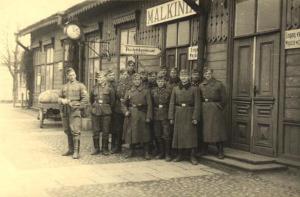 |
| From Embassy of Poland, Washington DC Facebook page |
Remember it was 70 years ago, and those who survive are getting older and eventually, like many other things, will be gone in the future. Some of those who have lived through it, and still suffer from the memories, will leave their stories behind, so hopefully the world will never forget what happened at these places. And some have already left us - and their families have to keep them alive by telling their stories. CNN had many personal stories and NBC also had them. One survivor tells how she walked out of gas chamber alive.
What does "At These Places" mean?
Yes, I did mean to say, at these places. I think many people forget or misunderstand that there was more than just ONE PLACE where these murders happened. They were throughout Europe and not just in Germany or Poland. There was no POLISH DEATH CAMPS - they were Nazi death camps. Why? By looking at the image below gives people a greater understanding for where exactly the death camps and the concentration camps were/are. They were NOT just in Poland and the Polish people were some of the hardest groups that were slain in these areas. Some of the land has been "reclaimed" and no longer exist and others still do exist and either are not publicized or very well known about.
 |
| Only part of the map of Europe's camps - taken from http://www.bobbickel.com/edfn520/section10/applications10c_files/image002.gif |
 |
| Taken from http://en.wikipedia.org/wiki/File:WW2-Holocaust-Europe-2007Borders_DE.png |
Malkinia and Triblinka
For instance, when I was looking up information on my grandmother who put on her ship manifest "Malkinia" I went looking at maps and researching. I finally realized the name had changed to Małkinia Górna in current times, and this lead me to reading a blog post which talks about Malkinia Junction. I then asked myself - Why Malkinia Junction? Well it seems this was the "joining" point between the German/Polish railway lines and the Russian railway lines. It doesn't seem like anything, but when you read the blog posts you understand.
 |
| furtherglory's 2011 blog post picture |
"When train tracks were built in Russia in 1842, they were “broad gauge” or 1524 mm. (5 feet wide). Train tracks in Western Europe were based on the “standard gauge” or 4 ft. 8 1/2 inches. Western railroad cars could not run on the broad gauge tracks on the eastern side of the Bug river." - furtherglory's 2011 blog postIt doesn't seem like much but when you read about Triblinka Extermination Camp, you then understand why they used this tiny town to build such a camp - because of the train tracks. Its sad but explains so much.
How does Malkinia fit into this? Malkinia is only about 7 miles away from the Extermination Camp. Typically what happened was when the Nazi's took over a place like this, they would also go to the smaller villages and towns around it and would taken EVERYONE - not just the Jewish persons - EVERYONE and they would exterminate them ALL.
All... such a small word for many people's lives just because they lived in the wrong area. Most people think or misunderstand about who was at these camps. Sure they know about the Jewish people, but just think of all (there's that word again!) the millions of Romani, Roman Catholics, Poles, Slavs, and anyone else the Nazis considered inferior, undesirable or dangerous and they were KILLED and are now put under the umbrella Holocaust Victims.
Belgium and the Holocaust victims
Recently I've been following another family line of mine and this one was from Belgium. Upon looking around for information on my family and the areas they lived, I found the Nazi's made their trademark there as well - they killed people from tiny Belgium towns as well. It seems no one was safe.
 |
| Taken from Wikipedia - The Belgian version of the Yellow Badge, compulsory from 1942 |
Karen Silverstrim, MA Candidate wrote an article up titled "Overlooked Millions:Non-Jewish Victims of the Holocaust" which will give you more of the victim breakdowns.
We mustn't forget - ever. If we do forget, we will only be slated to repeat history and that would be a shame as all these people would have died for nothing. Every year at the end of January, we should just stop all that we are doing and think of these poor souls who had died, so these awful things will never be forgotten and we have learned from them.
 |
| General
Dwight Eisenhower inspected the Ohrdruf Nazi labor camp on April 12,
1945, while touring forward battle areas. It was the first camp in
Germany liberated by the Western Allies.Taken from
US National Archives Facebook post
|
No comments:
Post a Comment